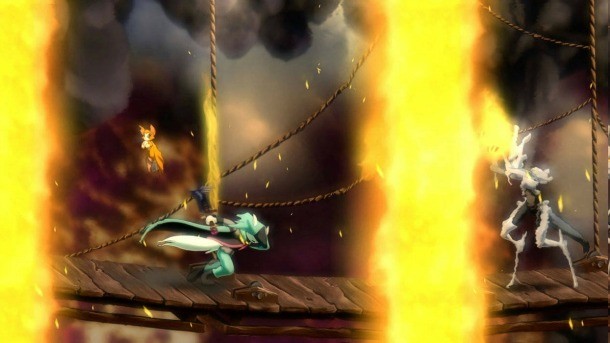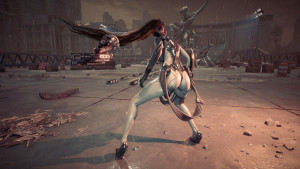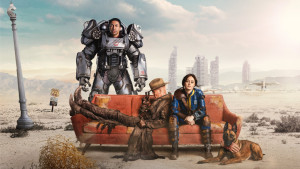Please support Game Informer. Print magazine subscriptions are less than $2 per issue
Afterwords – Dust: An Elysian Tail

Dust: An Elysian Tail first grabbed gamers' attention as the winner of Microsoft's Dream Build Play competition in 2009. Developer Humble Hearts (comprised of its one-man team, Dean Dodrill) spent the intervening years crafting Dust into one of the best downloadable titles on XBLA. When it finally released in August, the game proved to be the standout in Microsoft's yearly Summer of Arcade promotion, winning praise from gamers and critics (I loved it, by the way). To give some insight into this excellent game and the extraordinary process behind it, Dodrill answered a barrage of questions about his goals and inspirations for Dust, as well as its future.
GI: Dust was largely developed by a one-man team – an impressive feat these days. What elements of the game didn’t you handle yourself?
Dodrill: Thanks. Yeah, doing all the art, code, and design myself was grueling, but I had help in some very important areas.
The musical score was handled by Chris Geehan and Dan Byrne-McCullough (HyperDuck SoundWorks). HyperDuck also took over sound effect duties and redid most of my earlier audio. Additional music were produced by Alex Brandon (Funky Rustic).
Casting director Deven Mack worked with me to audition all the voice talent, and he personally directed and edited all the lines, which HyperDuck and I prepared for the game. Of course there are the over 40 talented actors who lent their voices to the game.
Finally, Alex Kain came halfway into the third year to polish up my script and assist with nailing down unfinished story bits.
Playing Dust, it feels like pieces from many different games and genres were assembled to form a “dream game.” Was that the case?
Definitely. I’ve often said that Dust: AET is my love letter to a variety of genres, and there are a number of specific games (some of which I blatantly “homage”) that I can name.
The most obvious influence would probably be the Castlevania series, with Simon’s Quest, Symphony of the Night, and Order of Ecclesia being the main inspirations. Also, any 2D game with the open world formula, such as Blaster Master, Cadash, and Metroid.
There’s a bit of Strider and Megaman within the combat, and the projectile combat is heavily influenced by side scrolling shooters of the 8- and 32-bit eras. The combo-based combat references more modern games, like Devil May Cry and Xbox-era Ninja Gaiden.
The role-playing elements (story, quests, loot) kind of come from everywhere, but mostly from JRPGs. My favorite console was the TurboGrafx 16, and I love role-playing stories from that era. My favorite game of all time, Ys Book I & II, somehow finds its way into everything I do.
Art and programming are usually completely different departments when making a game with a bigger team. What are the advantages to splitting your time between them both?
Since I’m visually oriented, and most of my programming duties were to achieve something visual on screen, I found that I was able to work incredibly fast and iterate much more efficiently than if I had had to spend time consulting another team member.
Nearly every evening I would take a couple hours to retouch visual effects, whether through the art or code, and found that to be the most enjoyable part of making the game. I suppose I’m pretty technically minded, as an artist, and wouldn’t mind a future just doing visual effects. I do enjoy handling both sides, mainly because it kept my work from getting too dull. Whenever I felt burned out doing background art, I could jump into code and work on inventory or UI. There are certainly disadvantages to having to do everything, but it’s what kept the job exciting.
The art style is beautiful, and has drawn comparisons to everything from Disney movies to games like Odin Sphere. What can you tell us about your goals for the visual experience of Dust?
Dust: AET is actually based on a film I had been working on (with a different story/characters), so that’s where I drew the visual inspiration. And both borrow heavily from Disney and Studio Ghibli fantasy. Hand-drawn, flat-colored traditional animation on hand-painted backgrounds.
I create all the art in the game in the same way I create it for the film, which is very tedious but it gives it that animated film look. And although it was a massive technical challenge, I wanted to fully hand-animate the protagonist without using segmented or polygonal animation, which most 2D games use these days. I think it helps the animation to stand out, although squeezing hundreds of hi-def frames into RAM was a technical nightmare.
A surprisingly divisive aspect of Dust was the use anthropomorphized animal characters. Did you expect that some gamers would have such strong negative reactions to that decision?
I sort of knew going in that the visual style would be a turnoff to some, but I admit I wasn’t expecting how divisive it was. I think a big part of it is age, and what the audience grew up with. I’m 35, and grew up when a large number of game characters were animals, and talking animals were the norm on animated shows and movies.
But the internet happened, kids grew up with seemingly “mature” games, and a nasty stigma was attached to anthropomorphized animals. In hindsight I wouldn’t have changed anything, since I chose animals for very specific reasons (ease of animation, unique visual look, and to tastefully tell a story of a race war), but yeah, I think it’s an unfortunate reality of where tastes have gone. I sort of wish there was more character variety in video games these days.
Next: Cameos, boss fights, and what ended up on the cutting room floor...

Characters from Braid, Super Meat Boy, and other games make cameo appearances. How did that cooperation come about?
In most cases it was simply a matter of asking, and convincing the developers that I wasn’t trying to capitalize on their creations. I genuinely just wanted to show my respect to other independent developers that I love and that have influenced me. I’m quite honored that so many developers said yes, and I hope that players who find the cameos are reminded how they loved those games so much.
Some gamers see a 2D title and assume that its gameplay must be simplistic. Was it tough at any point to sell the concept of a deep, combo-driven combat system couched in those visuals?
In screenshots yes. Thankfully Dust: AET is pretty easy to show off in motion. It’s actually harder to show off the role-playing aspects and the story. The visuals are colorful and bright, and it takes a little convincing that this is actually a fairly dark story, with comedic bits to keep it entertaining.
Fortunately, the combat is extremely easy to pick up, since a few presses of a button result in immediate satisfaction. Had I stuck with a pixel-art look (which is actually something I initially considered), then yes, I think the combat would have been a harder sell. I think the full visuals help the game stand out among other indie games.
Finally, I’m not much of a “design doc” kind of guy. I’d rather just prototype it and create the art, so I never had to pitch the concept without having actual gameplay to back it up. One of the other benefits of being indie.
During game development, some features inevitably need to be cut. Can you talk about any abilities or story content that didn’t make the final version?
There were a number of early mechanics that I cut simply to be realistic about my goals, such as farming, fishing, owning land. The scope of the sidequests was also toned down to be more realistic as a downloadable title.
Late into development a large section of the third act was removed, narratively speaking, to strengthen what eventually made it into the final game. Part of it was to help with pacing, the other was to be realistic with my schedule and not spend an additional two years on development. This required some rewriting of previous events, but rest assured, the game is better for it.
In hindsight I would have liked to add more regions, more quests, more bosses. Always more. But the game shipped with a healthy amount of content and I’m very happy with the story. Being my first game, I wanted to keep “feature-creep” to a minimum.

One of the few complaints leveled against Dust was the ease of boss battles. What was your approach to designing and balancing these encounters?
The bosses admittedly didn’t receive the amount of time I would have liked. While they had been written and planned right from the start, they were implemented fairly late under a difficult crunch. There were only a handful of people who were actually testing the game for balancing, and adjusting stats between four difficulties could have been handled more elegantly.
Still, I’m happy with the encounters, and the context within which they lie. I do recommend the game on Tough for seasoned gamers, particularly in how loot and energy regeneration become more of a managed mechanic, and make all encounters much more enjoyable.
I understand if you can’t talk specific numbers, but generally, how has Dust performed? Did sales meet expectations? Did it make enough money to help fund future development efforts?
It’s interesting, I worked so hard on the game and the crunch was so grueling that I never really set sales expectations. That said, Dust: AET has been doing well. It won’t allow me to expand or anything, but at least I can continue making games. I’m still doing this myself, and do everything I can to keep costs down. Thankfully these last few years were well worth it, if nothing more than to say I accomplished my goal of learning how to make a game.

Some indie developers don’t have a high opinion of how Microsoft handles its XBLA titles. Considering that Microsoft’s support is what made Dust possible, what’s your impression?
I’ve read the horror stories as well, however I’m happy to say that my relationship with the XBLA team has been fantastic. I’m close friends with my producer, Andrew Williams, and everyone at Microsoft has been a pleasure to work with. They were understanding of me as a new independent developer, and allowed me to create the game I wanted. Of course, I’ve never made a game with anyone else, but I’m excited to work with Microsoft again.
I’d imagine that you’re about ready to take a break for a while, but do you have any interest in doing a sequel to Dust in the future? The ending certainly leaves the door open.
I am excited to revisit this story. I’ve got quite a few ideas, but right now I’d like to try and do something different with a new IP. I didn’t really get to spend a lot of time experimenting as a new game designer, and there are some genres and mechanics that I’m dying to dabble with. But rest assured, I’ll revisit Dust: AET at some point. I’ve grown rather fond of that world.










